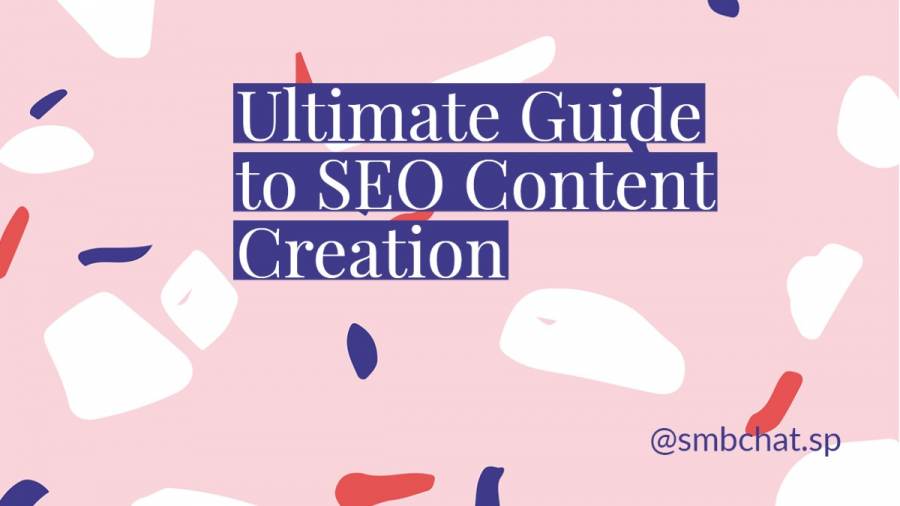The Ultimate Guide to SEO Copywriting
Want to know the quickest way to rank on page 1000 of Google?
Ignore copywriting—commission blog posts that heap praise on your "5-year grand plan" and whatnot, or better yet, spend time slapping your website with all the latest bells and whistles.
Sounds silly, right?
Yet, that's how some business owners are running their blogs (even in 2021).
The solution is obvious: you need to learn the ins and outs of copywriting, specifically SEO copywriting.
Easy.
Armed with nothing more than a bunch of SEO tools, you spend half your time churning out keyword-staffed content, and the rest praying that your target audience and search engines love it.
Fortunately, you don't need to do all that.
You just need a comprehensive guide to SEO copywriting, one that beats the crap out of all the existing comprehensive guides. One you can go back to every time your content strategy needs some pick-me-up.
Well, count yourself lucky because you just stumbled upon one.
Stick around, and I'll guide you through every SEO copywriting nugget there is to know. I don't fancy making promises, but take it from me, this is the guide you need to banish all those page-1000 nightmares you've been getting of late.
Wait, Is SEO Copywriting Actually a Thing?
There's a high chance the very first time you read the word copywriting next to SEO; you may have dismissed it as a spelling error. Oh, the many failures of our education system.
Turns out copywriting is a word by itself that has almost nothing to do with SEO (apologies education system).
SEO copywriting is the process of creating content that delivers maximum value and readability to both Google and regular users looking for information.
Well, isn't that like the hardest thing to do next to breaking out of the Alcatraz Federal Penitentiary? Or is it?
SEO copywriting involves creating content that:
- Targets some specific keywords so that other people can promote it
- Provides answers or relevant information for search queries
- Follows a specific, well-laid-out content structure that's easy enough for both your target audience and search engines to read
- Gets into the good books of the over 10,000 human quality checkers that Google has employed to determine who should be on top of SERPs
- People can fall head over heels in love with, at first glance
Did you know that 20+years of eye-tracking research has confirmed that most internet users only skim and skip around a webpage for relevant info? (Nielsen Norman Group)
Is SEO Copywriting Really That Important?
Do you really need an SEO copywriting strategy?
Well, no more than your cereal needs milk or your body needs clothes.
Sure, you can get by without it, but that would mean more nights staring at the ceiling when you'd rather dream about that Toyota Avalon you saw the other day.
Here are a few data-backed ways having an SEO copywriting strategy can help you:
- Maximize your ROI: Organic search drives more than 50% of all website traffic. Overlook SEO copywriting, and you're not only turning away prospective customers but also telling your competitors, "Hey, wanna have a few of my soon-to-be paying clients?"
- Build a strong online presence: Around 93% of all online experiences begin with a search engine like Google or Yahoo. Need I say more?
- Rank on page 1 of Google: Only 25% of people go to the second page of search results. The remaining 75%? They secretly wish page 2 never existed, let alone page 1000. The bottom line? Take SEO copywriting seriously, and you'll be making an epic entrance into page 1 of Google (and your prospective customers' pockets, wink)
So, what's stopping content marketers from dipping their toes into the copywriting waters? Well, let's just say they are yet to bump into the power-packed SEO copywriting tips I've unloaded below—but you did!
Now take a seat, your royal awesomeness. You're about to get thrilled.
The Art Of Writing For Search Engines & Humans: How to Ace SEO Copywriting in 7 Simple Steps
Step #1: On Your Max, Get Set…Keyword Research
"Keyword research" may have become an overused word, but it has certainly not lost its mojo. Every great SEO copywriting journey starts with keyword research, so don't skip this step.
Out of all the SEO tools available out there (think: Google Keyword Planner, SEMrush, Ubersuggest, etc.), pick your favorite.
Don't be biased, though. Only settle for a tool that gets the job done in just about 5 minutes. OK, it might take much longer than that, but you get the picture. Once you're all settled, get into the business of finding the relevant keyword for your website's established niche.
The outcome of the keyword research process is a list of keywords:
- That can potentially bring you traffic. Trying to rank for keywords that won't generate website visits is a waste of time and money. You're better off spending those bucks on a bottle or two of Budweiser.
- That can increase your conversion rate. In other words, a relevant keyword, one that's aligned with your business goals to generate leads, sales, or affiliate links.
- You can actually rank for. The web is a saturated place, awash with millions of competitive keywords. Unfortunately, you can't rank for all the keywords you want.
That said, here are a few keyword research best practices to remember:
- Think as your potential customers would and try generating different search terms yourself
- If you are a new kid on the content marketing block, start with long-tail keywords. Long-tail keywords make up 70% of all searches. They're a low-hanging fruit too, so they are super easy to rank for.
- Keyword relevance is a no-brainer. Only settle for keywords that are relevant to your target markets. Everything else is noise.
- Have a healthy mix of long-tail keywords and short-tail keywords. Short-tail or seed keywords are typically shorter in length, have more competition, and often rank higher than their long-tail counterparts.
- Keyword density doesn't really bear significance. It's the relevance that truly matters.
- Find non-branded keywords that your competitors are ranking for.
Before diving into the next step, you'll want to narrow down your list of target keywords to about 20 or so. But that’s just the beginning.
Use a tool like Wordtracker to glean your keyword list further to about 5 relevant keywords. You can pick one overarching target keyword, but my recommendation is to stick with all five keywords. They’ll come in handy when generating content ideas.
Step #2: Understand the Depths of Search Intent
Why did the chicken cross the road? We'll likely never find out.
But if you type this into a search engine, I'm pretty sure I can predict what the top results might return.
Not only because I've searched for this myself, but also because of something called search intent.
This basically means that search engines are trying to give you what you want by first understanding (or guessing) what it is that you want and—more crucially—why you want it.
Guess what? Search intent is the next step in our SEO content writing journey!
In this phase, you're putting each target keyword (from Step 1) into perspective based on why someone is searching for it on Google and how they intend to use the information.
Is it a difficult thing to do?
Maybe.
Or maybe not.
I'd say it's a bit uncomfortable, but it's certainly worth it.
Let's say, for instance, we're targeting [sunglasses] as the primary keyword.
What is your target audience actually searching for?
- The cheapest sunglasses?
- Sunglasses polarized meaning?
- Ray-Ban sunglasses?
All of these search queries represent different search intents:
- "Cheapest sunglasses": transactional
- "Sunglasses polarized meaning": informational
- "Ray-Ban sunglasses": navigational
If you are wondering which search intent is the most popular, here's your answer:
More than 80% of the total search intents are actually informational. The remaining 20% are split almost equally between transactional and informational.
By now, you might be thinking: “OK, that's great. So does it mean that I should spend most of my time writing informational content?”
Well, not really.
I believe that all three categories of search intent need your attention as they can be seen as a cycle in the customer journey, not individual searches.
All in all, understanding search intent is crucial as it allows you to deviate from crafting fluffy, lifeless, or otherwise needless content.
In case you need a few best practices to mull over, here are a few:
- Use a tool such as TextOptimizer to help you optimize your primary keyword(s) for search intent
- Add a graph (flow chart) to give more depth to the concept
- Make sure the key takeaways are fleshed out in clear, concise steps
- Sprinkle in some bullet points here and there
Step #3: Map Out the Customer Journey
Remember the last time you had a headache?
The first thing you likely did was try to figure out the cause. Perhaps you were sick, caffeine-depleted, or maybe you were just dehydrated.
After you diagnosed the problem, you moved on to solutions—grab an espresso, drink some water, or take some medicine.
Finally, you decided between solutions: Evian or tap water? Peet's coffee or Starbucks? Tylenol or Aleve? Hopefully, your headache subsided, and you were able to go about your day.
This is a representation of the buyer's journey. Each of your prospective customers follows a path to a solution—that path involves awareness, consideration, and decision stages.
However, each of your prospects is in a different part of that journey, so it's important to use your content piece to appeal to each stage.
Luckily for you, you’ve got your audience’s search intents all sorted out. All you've got to do at this point is map your primary keyword to your buyer's journey using intent as a guide.
The visualization below demonstrates how each search intent type maps onto different stages of the customer journey:
Source: Ahref
By aligning your content creation process with each stage of the buyer's journey, you're ensuring that no visitors fall through the cracks and that every individual that comes to your site feels like they're receiving valuable
content.
Got it?
Onto the next stage of our SEO copywriting journey…
Step #4: Flesh Out Your Content Outline
Target keyword?
Check.
Search intent?
Check.
Buyer's journey?
Check-check.
Time to start writing?
…Not yet.
Before you dive into the content creation process, you need to lay out the nitty-gritty of your content outline.
Of course, every company's content outline will look and function differently, but your outline should answer some main commonalities.
Here are a few questions to ask yourself before you begin writing:
- Who is my content for? Understanding who will be searching for and reading your blog content is just as important as knowing what you'll be writing about. If you're talking to people who are interested in pets and dogs, you'll definitely want to create content that features or includes dogs.
- What is the purpose of this piece of content? Successful content not only needs to reach your target audience, but it also needs to: inform, educate, solve a problem, or promote a product or service. It can be one of those or any working combination. The choice, ultimately, is yours.
- What do I want to achieve? What's your end goal? Are you hoping to reduce your bounce rate? Do you want to soar to the top of search rankings? Or perhaps you want to rake in more organic traffic?
- How will I structure my blog content? Are you planning to outline a problem first then tackle it later on in the blog article? Or perhaps you want to order your information in a Q&A manner?
Keep in mind that Google and other search engines reward readability and meticulousness. So you'll want to use a content outline to make your writing as flawless and logical as possible.
Still skeptical about a content outline?
I got you.
Here are more reasons to incorporate a content outline into your copywriting process:
- Makes your content comprehensive: A comprehensive piece of content (like this one, wink) will always win the battle with short, quick-snack types of content. If you take a look at the graph below, you'll notice a strong correlation between depth of content and high search engine rankings.
Source: Sweor
- Ramps up content creation: If you really want to move the needle with your SEO copywriting strategy, data from HubSpot suggests that you must publish quality content not once, not twice, but thrice every week. The best-case scenario is 4-5 blog posts per week.
Step #5: Structure Your Content Into Manageable Chunks.
Haven't you heard that the "great wall-of-text" is your target audience's worst nightmare?
Thought you should know.
Structuring your blog content should be part of your outlining process, so it's best if you do them concurrently. In as much as it's tempting to dive into writing without a well-thought-out content structure in place, don't.
That said, here are a few best practices to keep in mind as you structure your content:
- Write for the human audience. Humans, aka your prospective customers, hate long, compact blocks of text that are difficult to read, especially on mobile devices.
- For each relevant keyword that aligns with specific user intent, break it down into topics. Again, TextOptimizer comes in handy in this regard.
- Once you have a general idea of the topic you're supposed to write on, break it down further into subtopics using H2/H3 headers. For each subheading that you generate, make sure it:
- Reflects your content hierarchy
- Is descriptive
- Includes your target keyword
- Always provide a definition whenever there's a mention of a niche terminology. This could be the perfect opportunity to build at least some brand familiarity since Google loves showing a quick explanation or definition.
- Make visual media your best friend. Other than H3 and H2 headers, break up text with images, videos, and white space.
Step #6: Time to Write Dat Ding!
Admit it.
You've been champing on the bit for a chance to actually write some Google-worthy content. Yes, you've taken to heart all of the nuggets I’ve unloaded here, but you just want to see high-quality content come to life. At some point, you hurriedly scrolled down this blog post just to get a glimpse of how to craft compelling content.
Well, here you are (yay!)
All of that prep work prior to this stage is what separates successful SEO copywriting from run-of-the-mill types of content cranked out with minimal effort.
As you craft your copy, keep your target keyword and audience in mind, but remember to let the writing flow naturally and logically.
Be sure to include your primary keyword in at least the first paragraph, the first subheading, and the conclusion.
Yes, you can include secondary or tertiary keywords elsewhere, but be careful not to disorient the flow and gist of the piece. Most SEO professionals believe the ideal keyword frequency to be between 1-2%.
Here are more writing best practices to keep in mind:
- Write your persona. Use your audience's voice, personality, tone, and even their humor to come up with pieces of content that hit them right in the feels.
- Use catchy headlines. Your headlines should spark interest, stir an emotion, and make them want to kick their feet up for a read.
- Content quality is non-negotiable. Do away with the fluff, use metaphors, as well as use powerful prose to entertain and delight your target audience.
- Be clear and concise. You want your prospective customers to derive value from your content, not muddle through confusing jargon and metaphor.
- Utilize a strong linking strategy. Consider your niche when adding internal links, external links, and backlinks to your final copy. While it's not one-to-one, here's a good rule of thumb: internal links for sales funnel, external links for thought leadership, backlinks for everyone.
#Step 7: Edit, Ruthlessly
Congratulations!
You've done all the hard work. You've summoned all the creativity, wit, and energy in your writing locker to create show-stopping, relevant content. It's now time to roll it out to the world.
But wait a minute.
Have you actually polished the blog? Have you weeded out all the clunky text and insipid headlines?
Editing is, without a doubt, a subjective process. Some content creators may want to edit their work on the go. Others may prefer to wait a few days to skim through the piece of content with a fresh pair of eyes.
Either way, take the time to comb through your prose to ensure you're offering your reader the cleanest material you possibly can.
Remember, typos, disorganization, wall-of-text, subpar research, and other errors can take a serious hit on your credibility. Editing ensures that every piece of content you publish is authoritative, trustworthy, and high-quality (which, btw, is Google's cup of tea).
Last but certainly not least, have a content calendar; it'll guide you in knowing when best to proofread and edit your content.
A Lot On Your Plate Already? We Can Help With Your SEO Copywriting Needs.
Not everyone has a natural-born talent for writing.
And that's okay.
But even if you had the talent, you'd rarely have time to craft high-quality pieces of content because, let's face it, most are the times that you doze off on the couch after an insanely tiresome day at work.
You need a hand, and you need it now. Else, your bounce rate will keep spiking; your conversions will keep dipping; your organic traffic will remain on a downward trajectory…it's an endless list of ways your business could suffer if you continue sidelining content writing.
Thankfully, Zoey Writers can help. We live and breathe SEO copywriting, and with the writing acumen and SEO experience we've garnered over the years, we believe we are the right candidates to relieve you of your copywriting burdens.
Why don't we hop on a quick call or shoot us an email and see if we're the right fit for your business?
Cheers.

















